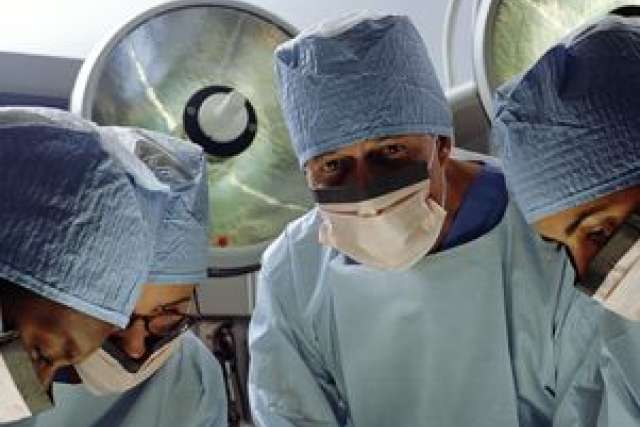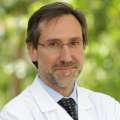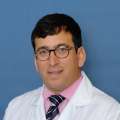In Westwood, more than 100 faculty experts from 25 departments have embarked on an all-encompassing push to cut the health and economic impacts of depression in half by the year 2050. The mammoth undertaking will rely on platforms developed by the new Institute for Precision Health, which will harness the power of big data and genomics to move toward individually tailored treatments and health-promotion strategies.
On the same 419 acres of land, researchers across the spectrum, from the laboratory bench to the patient bedside, are ushering in a potentially game-changing approach to turning the body’s immune defenses against cancer. At the same time, many of their colleagues have joined forces to explore a new scientific frontier: learning how the 40 trillion bacteria and other microbes residing within each person influence health and disease, and exploring the potential for manipulating them to cure what ails us.
This is UCLA — where, simultaneously with these broad-scale initiatives to fight disease, an unprecedented effort to become the nation’s healthiest campus has kicked into high gear.
Ambitious? Without a doubt. But as UCLA prepares to enter its second century, campus leaders are increasingly thinking big when it comes to health. In part, this is because what was previously insurmountable has become more doable thanks to ever-accelerating technology, along with giant strides in the molecular-level understanding of biology and the role of genetic and environmental factors in health. But even with these powerful new tools, few institutions have the requisite depth and breadth of expertise, the proximity of partners (unlike many universities, UCLA’s medical school and hospital are on one campus), and the culture of interdisciplinary collaboration to pull off such projects.
With these advantages comes a sense of obligation. “As one of the world’s top public research universities, we have a responsibility to work toward solving major societal problems for the people in our community,” says John C. Mazziotta, vice chancellor of UCLA Health Sciences and CEO of UCLA Health.
Solving Depression’s Mysteries
One of those problems is depression, diagnosed in approximately one-fifth of the population at some point in their lives. Most depressed people never receive treatment; for those who do, the treatments work only about half the time. That’s reflective of the mysteries surrounding depression’s causes and manifestations, according to Nelson Freimer, the Maggie G. Gilbert Professor of Psychiatry and Biobehavioral Sciences and director of the Center for Neurobehavioral Genetics in the Jane and Terry Semel Institute for Neuroscience and Human Behavior at UCLA.
“Depression is such a big problem that it can be solved only by a large-scale, comprehensive approach that embraces everything from basic brain science through genetics, clinical care, studies on economics and efforts to remove the stigma and increase the societal discussion about this illness,” Freimer says. “UCLA is one of the few places with the talent across all of these areas to take this on.”
UCLA’s Depression Grand Challenge, led by Freimer, is the university’s most ambitious research project to date, with an anticipated budget of $525 million for the first 10 years of its planned 35-year duration. The centerpiece is a 100,000-person genetic study to learn about the genetic and environmental factors that contribute to depression, as well as the molecular mechanisms and brain circuitry that characterize the condition. An innovative treatment center will capitalize on the findings to deliver new treatments and prevention strategies to the study’s participants. The grand challenge will also launch a research, outreach and education program aiming to eliminate the stigma associated with depression.
“Because of the impact depression has on so many families, we have an extraordinary opportunity to improve the public good,” says Peter Whybrow, director of the Semel Institute for Neuroscience and Human Behavior at UCLA. “But beyond the humanitarian concern, this challenge will allow us to learn a great deal about how the brain works and how genetics can drive behavior.”
The study into depression’s root causes is being made possible by the infrastructure established with the Institute for Precision Health at UCLA, launched earlier this year to take advantage of the technology-enabled opportunities to optimize the diagnosis and treatment of diseases. The institute will bring faculty from clinical specialties together with experts in information science, engineering, software and hardware development, human genetics, genomics, public health and the social sciences to move from a one-size-fits-all approach toward health care that accounts for individual differences in genetics and other factors.
“We’re just at the beginning of being able to interpret the huge amounts of electronic data we have on medical histories, laboratory and imaging tests, and genetics,” says Kelsey C. Martin, dean of the David Geffen School of Medicine at UCLA. “This is not something a company is going to do at this early stage. You need a collection of scholars who understand what it all means, and then another set of scholars to look at that information and make sense of it in a way that will provide insights into health and disease.”
Turning the Body’s Defenses Against Cancer
It’s not just that a public institution like UCLA takes on challenges that industry won’t. Martin suggests it took an institution with UCLA’s wide-ranging strengths in fundamental biology, cancer biology and immunology to help bring the most exciting current cancer treatment strategy to fruition.
The idea that the same biological system that protects us from harmful bacteria and viruses might be redirected to fight cancer isn’t new. For years, researchers sought to produce cancer vaccines, teaching the immune system to recognize and attack cancer cells as foreign invaders. The results were disappointing, and many predicted that the approach, known as immunotherapy, would never be successful.
But researchers discovered the source of the problem: Certain safeguards, known as checkpoints, kept the immune system from attacking organs — but also prevented it from going after cancer cells in the vaccine strategies. “We realized that if we took away the immune system’s brakes, then unleashed it, we could start to get durable responses,” says Antoni Ribas, professor of medicine and director of the UCLA Jonsson Comprehensive Cancer Center’s tumor immunology program.
More than a decade ago, a UCLA team headed by Ribas began developing the initial generation of checkpoint inhibitors, which led to the first approval of a PD-1 immune checkpoint inhibitor for cancer immunotherapy. Pembrolizumab (marketed as Keytruda) got the thumbs up from the U.S. Food and Drug Administration in 2014. Ribas’ group found that among patients in which the deadly skin cancer melanoma has spread throughout the body, 35-40 percent benefit from pembrolizumab, the majority of them for significantly longer than would have been possible with conventional treatments.
“Other types of conventional drugs tend to have benefits that are counted in months,” Ribas says. “We have benefits that are usually counted in years.” Among the beneficiaries: former President Jimmy Carter, who was successfully treated with the drug after his melanoma spread to his liver and brain.
In the last three years, five immune checkpoint inhibitor drugs have been approved, with benefits shown in eight cancers. “For lung cancer patients who benefit, this is better than anything before,” says Associate Professor of Hematology and Oncology Edward Garon M.S. ’14, who teamed with Ribas to pioneer the use of pembrolizumab in patients with the disease. Although only about one-fourth of patients with lung cancer derive significant benefits from the available immunotherapy drugs, some of those patients have now been in remission for as long as five years.
Ribas points out that the new class of immunotherapy drugs has thus far been ineffective in treating many of the most common cancers, including the majority of patients with breast, colon, pancreatic and prostate cancers. He and other researchers are now studying the impact of combining multiple checkpoint inhibitor drugs or using them in combination with other treatments. To maximize the potential for the research, UCLA recently joined with five of the nation’s other leading cancer centers and the Parker Institute for Cancer Immunotherapy to establish the Parker Institute for Cancer Immunotherapy at UCLA. Led by Ribas, the center will enable UCLA scientists to collaborate with other leading researchers, clinicians and industry partners toward the common goal of advancing immunotherapy to treat cancers.
Working Out the Bugs in Our System
Yet another large group of UCLA scientists are working together to learn about the microorganisms that populate the gut, skin and other body sites. Only in recent years have researchers begun to appreciate the profound health implications of our invisible cohabitants and the genes that produce them, collectively known as the microbiome. The field is young, but early evidence indicates an important role for microbes in heart disease, obesity, inflammatory bowel disease, dental and skin diseases, depression and perhaps even cancer and Parkinson’s disease. “We’re still just scratching at the surface, but the field is moving extremely fast,” says Emeran Mayer, a professor in UCLA’s departments of medicine, physiology, and psychiatry and biobehavioral sciences who is renowned for his research into the relationship between the gut and the brain.
For the most part, microbiome research remains more potential than reality. But a slew of tantalizing findings, along with the flood of venture-capital investments in companies seeking to capitalize on microbiome science, suggests that the potential for health benefits is both real and vast. UCLA has generated its share of the excitement. A team headed by Jake Lusis, a professor in the UCLA departments of medicine and microbiology, immunology, and molecular genetics, characterized a gut microbe-derived metabolite that contributes significantly to the risk of heart attacks and stroke. Another group, headed by Integrative Biology and Physiology Assistant Professor Elaine Hsiao ’06, has shown in animal studies that manipulating the microbiome can trigger changes in behavior, along with differences in brain function.
Mayer contributed to the intrigue with a widely publicized study with Kirsten Tillisch M.D. ’97, a UCLA associate professor of medicine, that offered the first evidence that regularly consuming beneficial bacteria through yogurt produces changes in the function of the brains of healthy women. Mayer is skeptical that diets will be prescribed as anything more than an auxiliary therapy for conditions like depression, Alzheimer’s or Parkinson’s. But he sees a more plausible path toward dietary strategies for optimizing gut microbiota, particularly early in life, starting during pregnancy.
With so much yet to be learned, researchers from disparate parts of the UCLA campus have joined together to establish the UCLA Microbiome Center in an effort to strategically advance the field. “The expertise here is phenomenal, and UCLA’s culture of working across disciplinary boundaries is a great strength,” says Mayer, one of the leaders of the effort.
Changing the Campus Culture
While scientists holed up in labs pore over the inner workings of cells and microbes on a quest to solve diseases, a very different but equally groundbreaking initiative to promote better health is continuing to unfold outside campus laboratories and clinics.
The UCLA Healthy Campus Initiative (HCI) was launched in 2013 with a simple but lofty goal: to transform UCLA into the nation’s healthiest campus by infusing a culture of well-being into the everyday environment, and by making it easier for UCLA students, faculty and staff to adopt healthy practices. HCI was envisioned and is supported by philanthropists Terry and Jane Semel. “Terry’s idea was that you can’t change the world, but what you can do is change one place, prove that it works, and then the rest will follow,” Jane Semel says of her husband, who headed Warner Bros. and Yahoo! Inc. over the course of his business career.
“Rather than a specific intervention, we are focused on the entire community in a way that will be sustainable over time,” says Wendy Slusser, a UCLA pediatrician who serves as associate vice provost for HCI. “We’re building on the idea that by bringing together like-minded people, we can advance a social goal much faster and more effectively than if everyone is working in isolation.”
HCI has brought about changes both subtle and obvious. Campus eateries feature healthier menu options, while vending machines now present nutritious snacks at eye level and above, where they’re more likely to be purchased. Elevators include signs pointing to the stairs as an alternative. Bike lanes have been added and safety infrastructure improved. Since 2013, all tobacco products have been banned from the campus. Already, there are signs of Terry Semel’s prediction beginning to come true. HCI was a model for the Healthier Campus Initiative, launched in 2014 by the Partnership for a Healthier America, with more than 40 colleges enlisting.
Investing in Their Future, and Ours
If you’re looking for future leaders of large-scale health promotion efforts, look no further than Dr. Mariel Bailey.
While teaching in a low-income New York City public school through Teach For America, Bailey was struck by her students’ lack of access to basic preventive health care. She set her sights on medical school, knowing it wouldn’t be easy: For a first-generation college graduate from a family with limited means, medical school seemed prohibitively expensive. Nonetheless, Bailey decided she would take out loans. She was accepted into top programs, including Harvard, Stanford, UC San Francisco and UCLA, then learned she’d been chosen for a David Geffen Medical Scholarship, which would cover the entire cost of her four years at UCLA. The choice was clear.
For most medical students, the prospect of paying back loans to cover the cost of their education is daunting. The median debt for a graduating U.S. medical student in 2015 was $183,000. While the earnings potential of a practicing physician is significant, the looming debt can affect career choices. As a result, students who might otherwise gravitate toward careers serving vulnerable populations, developing creative solutions to health problems, or engaging in other important but less compensated pursuits are often dissuaded in favor of more lucrative options.
That’s no longer an issue for about one-fifth of each entering class at the David Geffen School of Medicine at UCLA, whose entire expenses are being covered thanks to a $100-million scholarship program funded by the entertainment executive and philanthropist after whom the school is named.
The scholarships are a boon for recruiting at a time when the medical school has committed itself to preparing physicians whose impact will extend beyond the care they provide to their patients. The forward-looking approach accelerated with the opening earlier this year of the 110,000-square-foot Geffen Hall, the first-ever physical hub for the medical school.
“The future of medicine depends on individuals who are both curious and fearless about solving problems and exploring mysteries we don’t understand yet,” says Martin, the medical school’s dean. “The Geffen scholarships allow us to recruit the top students in the country, then give them the freedom to pursue their passions without any financial burden. It has been transformative for us as a school.”
In June, the first nine Geffen scholars took the Hippocratic Oath as part of the 2017 graduating class. Among them was Mariel Bailey, who spent much of her extracurricular time developing new prevention strategies — including text-messaging and social media campaigns aimed at adolescents.
“I’m trying to do something novel, something that is unlikely to attract a lot of funding,” says Bailey, who is continuing her work while serving her residency in pediatrics and internal medicine at Brigham and Women’s Hospital and at Boston Children’s Hospital. “I’m able to do this because I don’t have the weight of loans to repay.”
Martin says that UCLA is the youngest of the nation’s 10 top-ranked medical schools, having produced its first graduates just over 60 years ago. “So many major discoveries have been made here in such a short period of time,” she says. “It creates a certain energy, as well as an expectation for more.”
Martin and other campus leaders point out that this entrepreneurial, can-do spirit has prevailed throughout UCLA’s history. But these days, it’s being applied to more sweeping ambitions, including some of the most important health challenges of the day.







